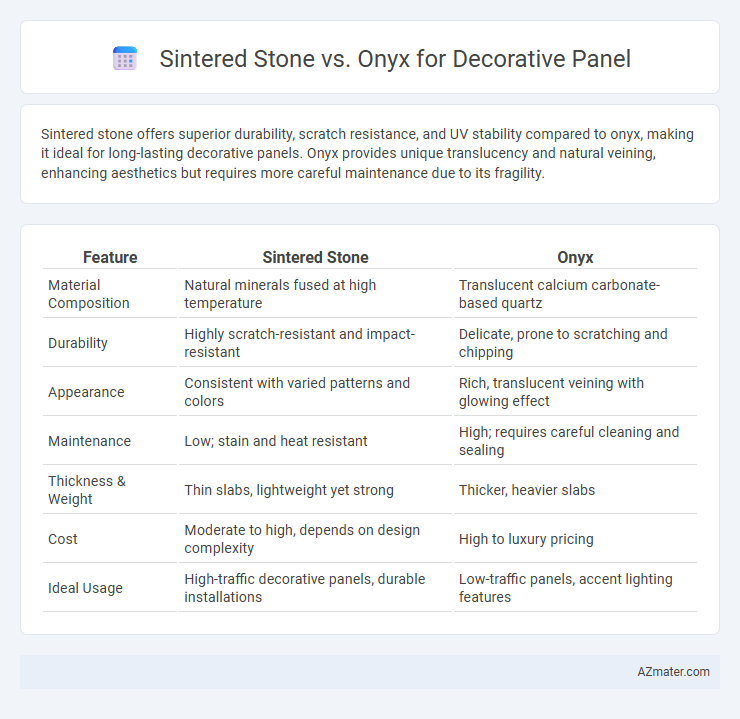Sintered stone offers superior durability, scratch resistance, and UV stability compared to onyx, making it ideal for long-lasting decorative panels. Onyx provides unique translucency and natural veining, enhancing aesthetics but requires more careful maintenance due to its fragility.
Table of Comparison
| Feature | Sintered Stone | Onyx |
|---|---|---|
| Material Composition | Natural minerals fused at high temperature | Translucent calcium carbonate-based quartz |
| Durability | Highly scratch-resistant and impact-resistant | Delicate, prone to scratching and chipping |
| Appearance | Consistent with varied patterns and colors | Rich, translucent veining with glowing effect |
| Maintenance | Low; stain and heat resistant | High; requires careful cleaning and sealing |
| Thickness & Weight | Thin slabs, lightweight yet strong | Thicker, heavier slabs |
| Cost | Moderate to high, depends on design complexity | High to luxury pricing |
| Ideal Usage | High-traffic decorative panels, durable installations | Low-traffic panels, accent lighting features |
Introduction to Sintered Stone and Onyx
Sintered stone is an engineered material composed of natural minerals fused under high heat and pressure, offering exceptional durability, resistance to scratches, stains, and heat, making it ideal for decorative panels. Onyx, a natural translucent stone known for its striking veining and luminous appearance, provides a luxurious, elegant aesthetic often enhanced with backlighting in decorative applications. While sintered stone excels in strength and low maintenance, onyx is prized for its unique beauty and artistic appeal, influencing the choice based on design and functional priorities.
Key Material Properties Compared
Sintered stone offers superior durability, scratch resistance, and UV stability, making it ideal for high-traffic decorative panels. Onyx, prized for its translucency and unique veining, provides unmatched aesthetic appeal but is softer and more prone to scratching and staining. Choosing between sintered stone and onyx depends on prioritizing either robust material performance or luxurious, light-enhancing visual effects.
Aesthetic Appeal and Design Flexibility
Sintered stone offers exceptional durability and a wide range of colors and finishes, making it ideal for achieving sleek, modern decorative panels with consistent texture and high resistance to scratches and stains. Onyx provides a unique aesthetic appeal with its translucent, natural veining and luminous qualities, allowing for dramatic backlighting effects that enhance luxury interiors. Design flexibility is greater with sintered stone due to its customizable sizes and ultra-thin options, while onyx requires more careful handling and limited panel sizes but excels in creating striking focal points.
Durability and Resistance to Damage
Sintered stone offers exceptional durability due to its high resistance to scratches, stains, and heat, making it ideal for long-lasting decorative panels. Onyx, while visually striking with its translucent qualities, is softer and more prone to scratching, chipping, and etching from acids, which limits its resistance to damage. For environments requiring robust performance, sintered stone provides superior strength and minimal maintenance compared to the more delicate nature of onyx.
Maintenance and Cleaning Requirements
Sintered stone offers superior durability and resists staining, making its maintenance straightforward with regular wiping using mild soap and water, while avoiding abrasive cleaners ensures its longevity. Onyx, being a softer and more porous natural stone, requires more delicate care, including gentle cleaning with pH-neutral products and immediate spill management to prevent etching or discoloration. For decorative panels, sintered stone demands less frequent sealing compared to onyx, which often needs professional sealing to maintain its glossy finish and structural integrity.
Cost Comparison: Sintered Stone vs Onyx
Sintered stone typically costs between $50 and $120 per square foot, offering a more affordable option compared to onyx, which ranges from $100 to $250 per square foot due to its natural rarity and translucency. Onyx panels require higher maintenance and specialized installation, further increasing overall expenses, whereas sintered stone is more durable and cost-effective for long-term use. Budget-conscious projects often favor sintered stone for decorative panels without compromising aesthetic appeal.
Installation Process and Complexity
Sintered stone panels offer a straightforward installation process due to their uniform thickness, lightweight nature, and resistance to moisture, making them easier to cut and handle on-site. Onyx panels require more precise and careful installation because of their natural translucency and fragility, often demanding specialized adhesives, backing support, and careful handling to avoid cracking or damage. The complexity of installing onyx increases with the need for backlighting elements and customized mounting systems to enhance its decorative appeal.
Environmental Impact and Sustainability
Sintered stone offers superior environmental sustainability due to its use of natural raw materials, low energy consumption during production, and recyclability, making it an eco-friendly choice for decorative panels. Onyx, while visually striking, is less sustainable since its extraction involves significant quarrying impact and limited recyclability. Choosing sintered stone supports reduced carbon footprint and promotes long-term ecological balance in interior design applications.
Best Applications for Decorative Panels
Sintered stone excels in decorative panels for high-traffic commercial spaces due to its durability, resistance to scratches, and UV stability, making it ideal for both indoor and outdoor applications. Onyx offers unique translucency and vibrant veining, perfect for backlit decorative panels in luxury interiors such as hotel lobbies, bars, and feature walls. Selecting between sintered stone and onyx depends on the balance of durability needs and aesthetic impact within the targeted decorative panel application.
Conclusion: Choosing the Ideal Material
Sintered stone offers exceptional durability, resistance to heat, scratches, and UV rays, making it an ideal choice for high-traffic decorative panels requiring long-term performance. Onyx, prized for its translucency and unique veining, excels in aesthetic appeal but demands careful handling due to its fragility and susceptibility to staining. Selecting the ideal material depends on balancing functional durability with desired visual impact in the specific decorative application.

Infographic: Sintered stone vs Onyx for Decorative panel
 azmater.com
azmater.com